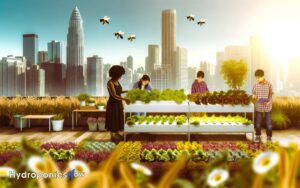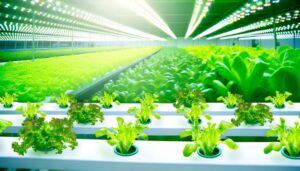Hydroponics and the Future of Farming
Hydroponics, a soilless cultivation method, is set to transform farming by maximizing resource efficiency and crop yields. It operates through delivering essential nutrients in a water-based solution, drastically reducing water use by up to 90%.
This method allows year-round production and mitigates soil-borne diseases, decreasing the need for chemical interventions. Technological innovations such as IoT connectivity and machine learning streamline operations, enhancing sustainability.
As the hydroponics industry is projected to grow at a CAGR of 20.7% through 2027, it aligns with UN Sustainable Development Goals, promising significant advancements in food security and sustainable agriculture.

Key Takeaways
- Enhanced Yield Efficiency: Hydroponics significantly boosts crop yields per square foot by optimizing nutrient delivery and environmental conditions.
- Water Conservation: Hydroponic systems use up to 90% less water compared to traditional soil farming, addressing global water scarcity challenges.
- Year-Round Production: Controlled environments in hydroponics enable continuous, year-round crop production, overcoming seasonal limitations.
- Reduced Environmental Impact: Vertical and urban hydroponic farming significantly cut down on land use, transportation emissions, and chemical interventions.
History of Hydroponics

The history of hydroponics can be traced back to the ancient civilizations of Babylon and Egypt, where early forms of soilless cultivation were employed. The Hanging Gardens of Babylon, one of the Seven Wonders of the Ancient World, utilized a rudimentary hydroponic system to sustain lush vegetation. Similarly, Egyptian hieroglyphs depict aquatic plant cultivation along the Nile.
In the 1930s, Dr. William Frederick Gericke of the University of California refined these techniques, coining the term 'hydroponics.' His work laid the foundation for modern hydroponic systems, which use nutrient-rich solutions to optimize plant growth.
The evolution of this technology has enabled controlled-environment agriculture (CEA) advancements, driving innovations in resource efficiency and crop yield optimization, vital for addressing global food security challenges.
How Hydroponics Works
Harnessing nutrient-rich water solutions, hydroponics operates by delivering essential minerals directly to plant roots, bypassing the need for soil.
This method utilizes a controlled environment where variables such as pH levels, nutrient concentration, and water temperature are meticulously regulated.
Various systems, including Deep Water Culture (DWC), Nutrient Film Technique (NFT), and Aeroponics, each offer unique mechanisms for nutrient delivery and root support.
In DWC, roots are submerged in oxygenated water, while NFT employs a thin film of nutrient solution flowing over roots.
Aeroponics, on the other hand, suspends roots in the air and intermittently mists them with nutrients.
These advanced techniques enhance plant growth efficiency and resource use, setting the stage for sustainable agricultural innovation.
Benefits of Hydroponic Farming

Hydroponic farming's advantages include considerably higher crop yields and reduced water usage compared to traditional soil-based agriculture. Through optimized nutrient delivery systems, plants receive precise amounts of essential minerals, promoting accelerated growth rates.
Empirical data indicates that hydroponic systems use up to 90% less water, addressing critical concerns of water scarcity. Additionally, hydroponics enables year-round production, mitigating seasonal limitations.
Controlled environments reduce the risk of pest infestations and diseases, leading to fewer chemical interventions. Vertical farming techniques, inherent to hydroponics, maximize space utilization, making urban agriculture viable.
In addition, the absence of soil eliminates soil-borne diseases and enhances root oxygenation, contributing to robust plant health. Collectively, these factors underscore hydroponics as a transformative approach in modern agricultural practices.
Types of Hydroponic Systems
Hydroponic systems are diverse, with the Nutrient Film Technique (NFT) and Deep Water Culture (DWC) among the most prominent.
NFT utilizes a constant, shallow stream of nutrient-rich water that flows over the plant roots, optimizing nutrient uptake.
In contrast, DWC suspends plant roots in oxygenated water, providing direct access to nutrients and promoting accelerated growth rates.
Nutrient Film Technique
Among various hydroponic systems, the Nutrient Film Technique (NFT) involves a continuous flow of nutrient solution over the roots, optimizing growth conditions by ensuring consistent nutrient and oxygen availability.
This system employs a shallow stream of nutrient-laden water that flows through sloped channels, allowing roots to absorb nutrients and oxygen efficiently. NFT is particularly advantageous for fast-growing plants, such as leafy greens and herbs, due to its ability to maintain precise control over nutrient delivery.
The system's efficiency is underscored by its minimal water usage and reduced nutrient waste. Additionally, NFT setups can be easily scaled and automated, making them ideal for both small-scale urban farms and large commercial operations aiming to maximize yield and resource efficiency.
Deep Water Culture
Utilizing a method where plant roots are submerged directly in a nutrient-rich, oxygenated solution, Deep Water Culture (DWC) emerges as a highly effective hydroponic system.
This technique maintains continuous access to essential nutrients and dissolved oxygen, resulting in accelerated growth rates and higher yields. DWC systems typically employ air pumps and air stones to guarantee ideal oxygenation, mitigating the risk of root diseases like pythium.
Research indicates that DWC can increase growth rates by up to 15% compared to traditional soil-based methods.
Additionally, DWC systems are relatively simple to set up and maintain, making them suitable for both commercial and residential applications.
The integration of automation technologies can also enhance system efficiency and productivity, offering a glimpse into the future of sustainable farming.
Key Nutrients for Plants

Essential macronutrients such as nitrogen, phosphorus, and potassium play a critical role in plant growth and development in hydroponic systems.
Nitrogen supports chlorophyll synthesis, vital for photosynthesis, while phosphorus is integral to energy transfer processes like ATP synthesis.
Potassium regulates stomatal function and osmotic balance, enhancing drought tolerance and nutrient uptake efficiency.
Micronutrients including iron, manganese, zinc, and copper are also essential, albeit in smaller quantities, for enzymatic activities and metabolic functions.
In hydroponics, nutrient solutions must be meticulously calibrated to guarantee peak concentrations of these elements, as deficiencies or toxicities can severely impact plant health.
Precision in nutrient management is key, facilitated by advanced monitoring technologies, guaranteeing sustainable and maximized crop yields in controlled environments.
Hydroponics Vs. Traditional Farming
Hydroponics, characterized by soil-less cultivation, offers a higher yield per square foot compared to traditional farming, due to its optimized nutrient delivery systems and controlled environment.
This method enhances water use efficiency, reducing consumption by up to 90% relative to soil-based agriculture. Additionally, hydroponics minimizes the risk of soil-borne diseases and pests, leading to lower pesticide usage.
Traditional farming, conversely, is subject to variable climatic conditions and soil quality, often resulting in inconsistent crop yields.
Moreover, hydroponics enables year-round production, independent of seasonal constraints, thereby stabilizing supply chains.
Urban Farming Solutions

Urban farming solutions offer significant advantages such as efficient space utilization through vertical farming techniques, leading to maximized crop yield per square meter.
These systems also promote sustainable crop production by minimizing water usage and eliminating soil degradation.
Furthermore, urban hydroponic farms provide community engagement opportunities, fostering local food networks and educational initiatives.
Efficient Space Utilization
Maximizing vertical space through hydroponic systems can greatly enhance agricultural productivity in densely populated urban environments.
Utilizing advanced stacking techniques and modular designs, hydroponic farms can achieve yields up to 10 times greater per square meter compared to traditional soil-based agriculture. Vertical farming minimizes the land footprint while supporting high-density crop cultivation, essential for meeting urban food demands.
Additionally, integrating controlled environment agriculture (CEA) with hydroponic systems optimizes resource use, from water to nutrients, ensuring maximum efficiency. Data-driven monitoring and automation further refine these systems, enabling precise control over growth conditions and reducing waste.
This approach not only addresses space constraints but also aligns with smart city initiatives, making urban farming a pivotal component of future urban development.
Sustainable Crop Production
Integrating vertical farming techniques with sustainable crop production systems can greatly reduce the environmental footprint of urban agriculture.
By utilizing hydroponic methods, vertical farms achieve up to 90% water savings compared to traditional soil-based agriculture. These systems also minimize land use, requiring only 10% of the space needed for conventional farming.
Advanced LED lighting and controlled-environment agriculture (CEA) optimize photosynthesis, resulting in higher yields and faster growth cycles. Additionally, nutrient recycling within closed-loop systems reduces waste and enhances resource efficiency.
Urban vertical farms can notably decrease transportation emissions by localizing food production, thereby contributing to a reduction in overall greenhouse gas emissions.
This integration presents a scalable solution for sustainable urban crop production, addressing both ecological and economic challenges.
Community Engagement Opportunities
Engaging local communities through educational workshops and participatory farming initiatives can greatly enhance the adoption and success of urban hydroponic systems. These initiatives foster a collaborative environment, allowing individuals to gain technical knowledge and hands-on experience. Data indicates that urban hydroponic farms have the potential to increase local food security by 30% and reduce transportation emissions by 20%.
| Initiative Type | Expected Outcome | Key Metrics |
|---|---|---|
| Educational Workshops | Knowledge Dissemination | Participant Attendance |
| Community Gardens | Increased Engagement | Plot Usage Rate |
| School Programs | Youth Involvement | Student Participation |
| Public Demonstrations | Awareness | Audience Size |
| Collaborative Projects | Innovation | Project Completion Rate |
These metrics underscore the importance of community engagement in driving urban hydroponic farming solutions.
Technological Innovations
Advancements in automation, sensor technology, and data analytics are revolutionizing the efficiency and precision of hydroponic farming systems.
Automated systems now enable real-time monitoring and adjustment of nutrient delivery, pH levels, and temperature, markedly reducing labor costs and human error.
High-resolution sensors provide granular data on plant health and growth metrics, facilitating early detection of issues and optimized resource allocation.
Data analytics platforms integrate this information, generating actionable insights that enhance yield prediction and resource management.
Innovations such as machine learning algorithms and IoT (Internet of Things) connectivity further streamline operations, allowing for predictive maintenance and continuous improvement.
These technological breakthroughs are driving unprecedented levels of productivity and sustainability in hydroponic agriculture, setting new benchmarks for modern farming practices.
Future Prospects

The future prospects of hydroponic farming are poised to be transformative, driven by advancements in biotechnology, sustainable practices, and global food security initiatives. As researchers develop more resilient crop varieties and optimize resource efficiency, hydroponic farming is expected to play a crucial role in addressing food scarcity. Governments and agricultural organizations are increasingly investing in these innovations, recognizing their potential to reduce land and water usage. Given this rapid progress, many people are beginning to ask, when was hydroponic farming invented, to better understand its evolution and impact on modern agriculture.
Precision agriculture technologies, such as AI-driven nutrient delivery systems and IoT-enabled growth monitoring, are set to optimize yield efficiency. Sustainable practices, including closed-loop water systems and renewable energy integration, promise to reduce the environmental footprint.
Furthermore, hydroponics aligns with United Nations Sustainable Development Goals, particularly in combating hunger and promoting responsible consumption.
Market projections forecast the hydroponics industry to grow at a compound annual growth rate (CAGR) of 20.7% through 2027. As urbanization accelerates, vertical farming within urban centers is anticipated to play a pivotal role in localizing food production, thereby enhancing food security.
Conclusion
Despite the evident superiority of hydroponics regarding resource efficiency, yield optimization, and scalability, it remains delightfully ironic that traditional soil-based agriculture continues to dominate global food production.
Perhaps the enticing simplicity of soil and rainwater obscures the compelling data supporting hydroponic systems.
As technological innovations advance, the reluctance to embrace hydroponics may be viewed as an anachronistic adherence to outdated methods rather than a sustainable strategy for future food security.






